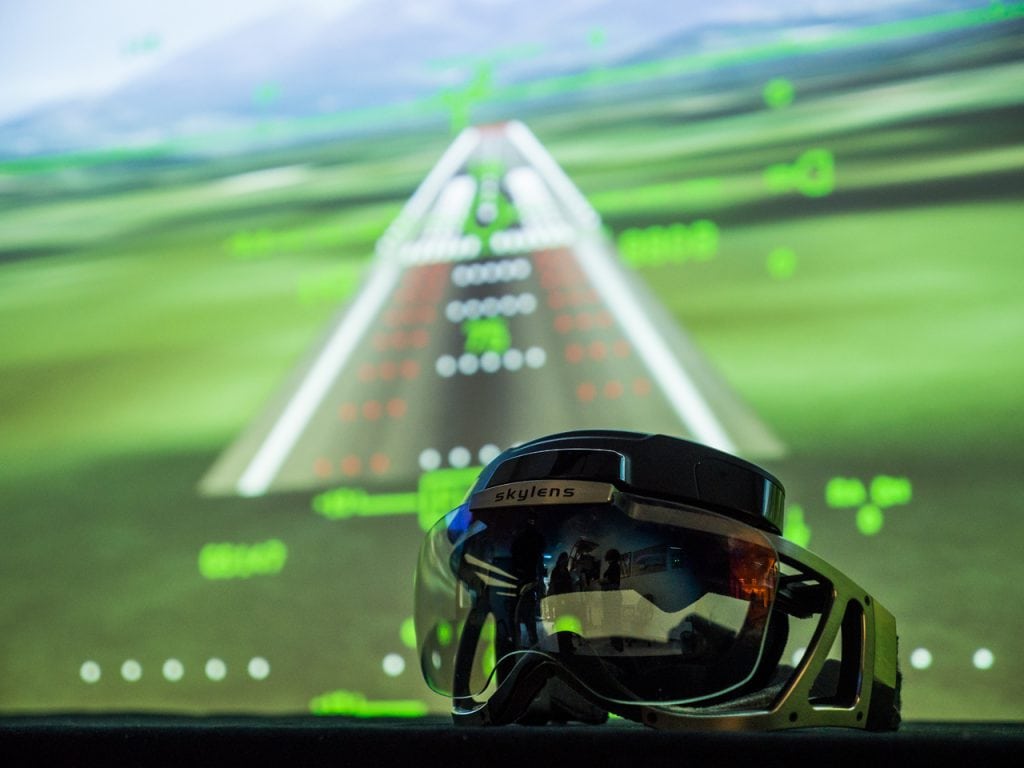
Elbit Systems 2020 Skylens. Photo courtesy of Elbit
As a combined entity, Elbit Systems and Universal Avionics can provide nearly every communications, navigation and surveillance functionality a modern airplane needs.
Elbit Systems completed its acquisition of Universal Avionics in April, making the Arizona-based OEM a wholly owned subsidiary, while keeping the Universal name in place. The acquisition has already driven growth in second quarter sales, according to Elbit.
Engineers from both companies are now working on synchronizing the functionality of Universal’s head-down displays with an array of Elbit’s innovative head-up display (HUD) technology. Universal Avionics CEO Paul DeHerrera told Avionics its engineers have already begun working with Elbit on the synchronization of its flat-panel display technology with Elbit’s Skylens wearable HUD.
To integrate SkyLens into Universal’s integrated flight deck, Insight, DeHerrera said engineers will need to match symbology between Universal’s head-down displays and Elbit’s HUDs.
“When you’re looking through SkyLens, you have a pitch ladder, air speeds, altitudes, flight path markers — the typical things you would expect to see in a HUD,” he said. “All of that symbology needs to be in alignment with our heads down symbology. You do not want the pilot to look at a completely different pitch ladder, you want that to be seamless. All of those things have to be aligned.”
The two companies exhibited at the 2018 Farnborough International Air Show a prototype of a repeater display, in which a co-pilot would be able to see exactly what the pilot-in-command is seeing on his or her HUD. The fusion of those systems will require a focus on getting the symbologies to match.
Universal also features synthetic vision within its flat-panel displays, a capability it will synchronize with Elbit’s HUD technology.
“We want to take the same database from our synthetic vision system and use that same database in the HUD. So when you see a mountain on the HUD, it looks the same as a mountain on the head-down display,” said DeHerrera.
According to Dror Yahav, VP of commercial aviation at Elbit Systems, the purchase of Universal will also expand its competitiveness as an avionics supplier into new segments of aviation. That, especially, will include aftermarket.
Yahav said one of the primary reasons Elbit developed SkyLens was the opportunity to supply a HUD that would have minimum modification impact on in-production cockpits. Now, with control over Universal’s integrated flight decks featuring flight management systems, ADS-B and CPDLC, among other technology, there are major aftermarket opportunities available.
“Universal has the infrastructure to support customers in the aftermarket, which we did not have previously,” Yahav told Avionics.
Elbit’s SkyLens HUD has seen adoption from ATR, Dassault Falcon Jet, Embraer, Gulfstream and Leonardo across a mix of business jets, commercial airliners and military aircraft as well. However, all of those adoptions were in line-fit equipage for in-production airframes.
Now, Yahav sees the opportunity to bring the company’s HUDs into the aftermarket.
“In the past, the technology itself was created with a vision of retrofit. Instead of using the big head-up display we sell for line fit, we’re going to start offering it as a retrofit,” he said. “Now that we have Universal, the aftermarket opportunities are there.”